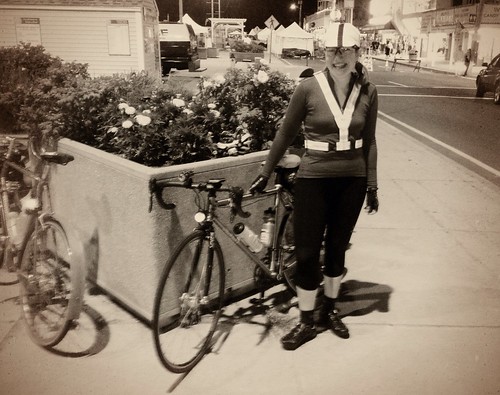
I still can't believe this, but over the weekend I took part in the first annual Dirigo Dynamo - an unsupported overnight bike ride from Boston to Maine along the New England coast, returning by train in the morning. An homage to the Dunwich Dynamoin the UK, the Dirigo Dynamo was designed to end at the seacoast and to coincide with the full moon.
Dirigo is the state motto of Maine and it means "I lead." When this ride was suggested to me, it sounded exciting and knowing both of the organisers (Jon and Brian) I had faith in their leadership. But I also had serious doubts about my ability to do it. The full length of the route was over 200K (120 miles), and I had not ridden that kind of distance before. Neither had I done long rides in the dark before, let alone any all-night rides. As the weekend of the Dirigo Dynamo approached I grew increasingly worried. Could I handle the miles? Could I handle the unlit roads? Could I ride through the night without sleep? Expressing these concerns to others was pointless, because for most cyclists I know a ride like this is either a piece of cake ("Of
course you should do it! How else will you ever work up to a 1200K?") or too absurd to contemplate ("Are you insane? You are taking this cycling thing too far!")

When I finally made up my mind to go, there was only a week left to prepare and I started making frantic changes to my bike. I swapped saddles twice, unable to decide which was less likely to cause me pain after 100 miles. I switched my tires for wider ones. And I borrowed a dynamo front wheel from a friend. I then quizzed every randonneur I knew about the merits of various reflective vests and helmet lights, finally acquiring these items days before the ride. In the end it all came together, and my bike - though looking rather frankenbikish - was well equipped for night riding on country roads.
I studied the route and made a plan, my strategy being to pace myself and stick with the slower riders. I also made a bail-out plan in the event of emergency. I thought carefully about food, deciding to opt for specific foods based on my experiences on previous rides.
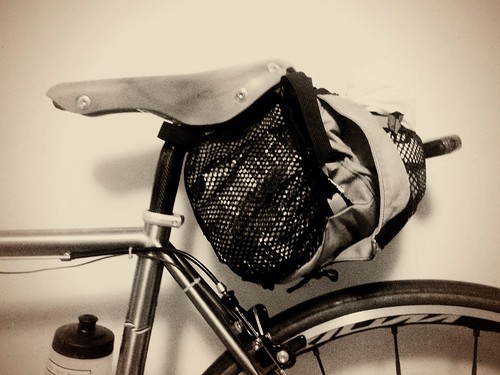
Everything I packed on the ride fit either into this deceptively small Dill Pickle bag or in my jersey pockets. This included: tools, two spare tubes, a bungee cord for securing the bike on the train later, a jacket, clear glasses for when it grew dark, band-aids, pain medication, sun screen, chamois cream, food, and a small toy cat (lucky charm). In my jersey pockets I carried money, ID, phone, and more food. I had the route downloaded on GPS and also brought cue-sheets in case the GPS malfunctioned or someone forgot theirs.
The food I carried included: 6 single packets of almond butter, a bag of sun-dried tomatoes,a bag of dried cranberries, a packet of Stinger "energy chews,"a banana, and a small carton of chocolate milk. There was a dinner stop planned at midnight, so this was meant to tide me over in addition to that meal. I filled my water bottles with a home made "salty lemonade" mix, over ice. One had a higher concentrated mixture than the other, identified by the colour of the bottle.

The meeting point for the ride was at 5:30pm on Saturday evening, at a cafe just a mile from where I live. I planned to stay up late the night before and sleep late on the day of our departure, but I was too nervous and woke up earlier than intended. All through the night I had anxious dreams. In one dream, my hands went numb and I lost the ability to shift gears, just as a hill was coming up. In another dream my dynamo light stopped working. Not only did I fail to get a good night sleep, but I was so nervous that I had trouble eating all day. But finally I force-fed myself an early dinner, got ready, and set off.

When I arrived, the reassuring sight of several familiar bikes calmed me down a bit. The Mercian, the Rawland, the Bianchi 650B conversion - I was in the right place. Before I even entered the cafe, I knew who would be there.There was a total of 6 of us gathered. In addition to the ride leaders I was pleased to spot JP Twins and Somervillain.

I also recognised Scott (on the right) from the Ride Studio Cafe. He comes to the Sunday rides but we'd never been introduced until now. I had mistakenly thought Scott was a racer, but it turns out he is a long distance rider. The only person in our group other than myself riding a modern roadbike, the contraptions he had it equipped with were fascinating.
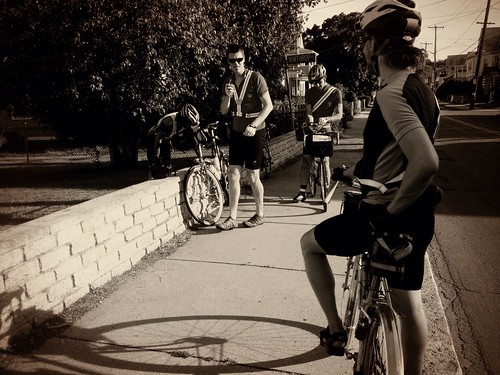
As planned, we set off at 6pm and aside from a quickly-resolved mechanical issue (loose fender bolt) our departure from Boston went off without incident. Nonetheless, I found this first leg of the trip to be highly stressful. There is no easy way to leave town heading North and for what must have been 10 miles we navigated busy suburban roads, with tricky intersections and impatient drivers, in 90 degree heat and humidity. The hyper-vigilance and constant clipping/unclipping this required exhausted me. But just when I was starting to feel worn out, it was over and we were cycling on idyllic country roads.
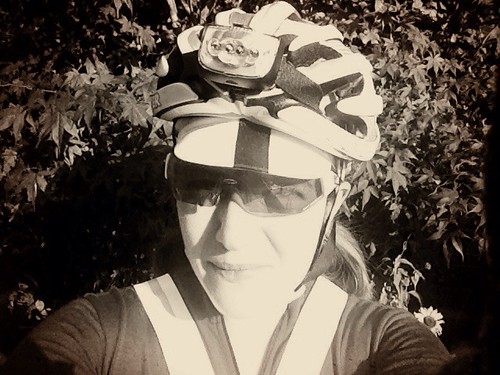
The interesting thing about a long distance ride is that it can go through personality changes. This was to be the first of many. As we headed North toward the New Hampshire border with the city behind us and the sun gently setting, I had the sensation of having broken free. The roads ahead were endless and beautiful. The ocean awaited.The temperature was dropping.The night's approach seemed like a friendly thing, not threatening. We were staying together as a group, and I felt good on the bike. Maybe I could do this after all.
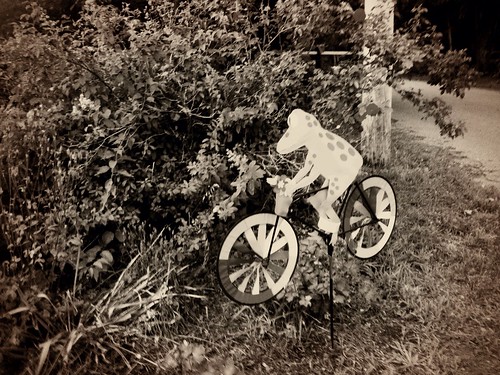
Before I knew it, we were at mile 25 and approaching our first rest stop. At this stage I had just gotten warmed up and was feeling remarkably good. The cycling frog that greeted us seemed to be cheering me on.

At this rest stop we visited Melinda - a well-known local randonneur - who would also be joining us from that point on. Here we were offered lemonade, bathroom facilities, and water for our bottles, before we promptly continued our journey.
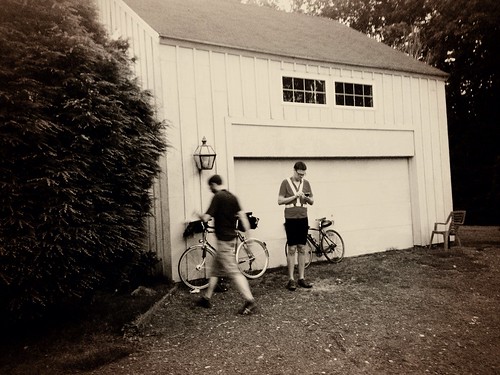
It was around this time that the sun began to set. I turned on my lights and tried not to get nervous about the approaching hours of darkness. Soon after we set off, there was a natural split into a faster and a slower group and I stayed with the slower. There were three of us: myself, Brian and Somervillain. It was agreed that we'd cycle together at a pace comfortable to all and by no means leave anyone behind in the dark.
The next 30 miles were the part of the ride during which I felt most energetic and optimistic. The night came gradually and there was no distinct moment when the realisation of darkness hit me. Some roads had occasional street lights installed, others were pitch black. When we rode under overarching trees it was darker than when we rode under an unobstructed sky with the full moon. There was a lot of variety and not just a blanket, uniform darkness. All three of us had excellent lights, and riding in a cluster we had a cozy little oasis of light surrounding us. Descending in the darkness was a thrill. I conserved my energy and coasted a great deal downhill, and without the visual context it felt like falling. Climbing in the dark was a different kind of thrill, because often I would not see the hill coming but would all of the sudden feel it - having to downshift quickly. I have no idea why I enjoyed this, but I did; it became a sort of game.

As we approached the New Hampshire border around mile 50, I felt strong and elated from the newness of cycling in the dark.And as if to celebrate this, we were greeted with fireworks. I have never watched fireworks while cycling before, so this was quite an experience. Just as we made a brief stop to eat and check our equipment, the last burst of them lit up the sky and we managed to take some feeble snapshots with our camera phones. We then proceeded across the bridge to the New Hampshire Seacoast - briefly catching up with the faster group, which was now joined by one more cyclist - Hugh, and his beautiful Heron bike. Once in New Hampshire, the 5 of them surged ahead again as we maintained our tamer pace. In another 20 miles, we would meet up for dinner in Portsmouth.

It is so odd how I can go from feeling great on a ride one moment, to not feeling as if I can continue the next. It happened around mile 65. We had just passed a precarious section of the New Hampshire Seacoast - Hampton Beach, with its rowdy drunk revelers and dense traffic - and were now continuing north through the gorgeous and quiet town of Rye. With the ocean on our right, saltwater marshes on our left and very few cars on the road, this was an idyllic stretch of the route. But suddenly - just as we were riding through the most scenic part - I felt a sharp pain in my lower back, like a strained muscle. This has never happened to me before, and I did not know what to make of it. So I ignored it at first, but it intensified to such an extent that I had to stop and stretch on the side of the road. When I got back on the bike it was fine at first, but just a couple of miles later the pain returned and became unbearable again. With just a few miles left before our dinner rest stop, I began to wonder whether I'd have to implement my emergency bail-out plan. This thought upset me, so I clenched my teeth and kept cycling, arriving at the Portsmouth Brewery around midnight and at mile 68, in terrible pain.
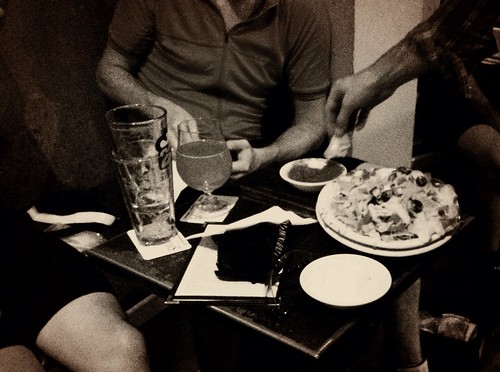
The faster group was already waiting for us, and they'd ordered plates heaping with nachos covered with vegetables and cheese, to which we gladly helped ourselves.
I then snuck away to the ladies' room with some diaper rash cream in my pocket. Now that I was off the bike for a few minutes, I became aware that I had developed painful rashes everywhere. What I saw in the florescent bathroom light was worse than I'd imagined: The skin around my shins was broken where it came in contact with the edges of my socks. The skin around my calves was broken where it came in contact with the hems of my cycling knickers. My wrists, the skin around my collarbone, and other, less publicly visible areas, were suffering the same fate. A couple of fingers on my right hand were bleeding from rubbing against the brake hoods. I have very sensitive skin and it must have been unusually humid for this to happen. I applied diaper rash cream everywhere I could and wrapped my fingers in band-aids. Later I took an Advil while eating some more nachos. I also went outside and stretched, trying to understand what muscle I'd pulled to cause the kind of pain I had experienced for the previous several miles. Would it improve after some stretching or would it only get worse over time?
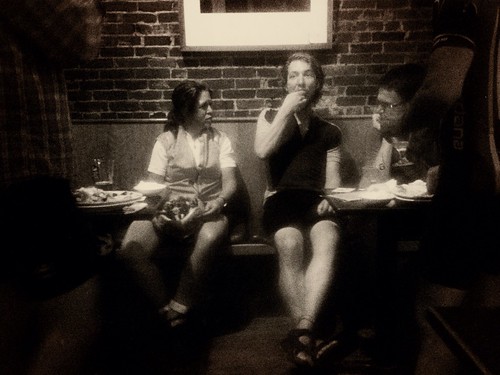
At dinner we learned about the other group's adventures. Apparently Melinda's derailleur had developed a problem, so she removed it, making do with a single ring. Later more things would go wrong and she would end up finishing the ride in single speed mode. Nonetheless they were all in good spirits and Jon impressed us with his beer drinking ability.
Amidst the merriment I was trying to decide what my course of action should be. What bothered me about the idea of bailing, was that I wasn't even tired. My legs were fine, I could keep pedaling. My energy levels were far from depleted. I ate, I drank, I went at a moderate pace - I'd done everything right. Where was this weird back pain coming from? As I brooded over this, my cycling companions suggested an alternative scenario: As the slower group, we could alter the route slightly and make our trip an even century (160K). As it happened, there was another train station at exactly this distance, making it a perfect end-point for the ride. Brian was under the weather and not feeling strong enough to do the 200K route. Somervillain did not mind the shorter option either. And for me, this would mean cycling "only" another 30 or so miles. Frankly, at that stageI did not feel that I could ride another 5 miles, let alone 30. But somehow this plan nonetheless seemed perfect and I did not want to break up our nice trio.
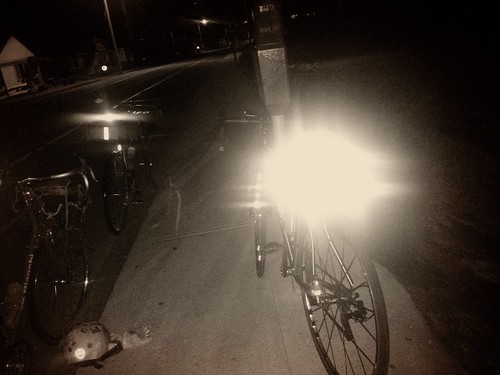
In order for the milage to work, we edited the rest of the route to hug the coast the entire way. The original route involved a lengthy detour, because the main bridge connecting Portsmouth, NH to Kittery, ME (they are separated by a bay) was under construction. However, I happened to know that there was an alternative bridge allowing for the same coastal crossing. Though technically not open to cyclists, in reality it was perfectly cyclable and allowed us a scenic and direct coastal route all the way to the train station in Wells, Maine, without the inland detour. This would make our total trip an even 100 miles. We said our good-byes to the fast group and set off.
I led the way to the nuclear submarine, behind which the onramp to the bridge was hidden, and we crossed over to Maine without incident. The next 25 miles were a bit of a blur. My back pain kept returning. When it got to be too much, I'd ask to stop and stretch. I was also grateful that Brian asked to stop occasionally. Our progress through this section was slow and laborious. It was a gorgeous route and I tried to enjoy the beauty and the quiet despite my discomfort.

The night was serene and welcoming. Rural Maine is spooky, but in a way I find to be almost seductive rather than outright scary. There were dilapidated farm houses, thick woods, endless marshes. We could smell the ocean on our right, but only barely see it, which added to the mystery. The full moon helped light the way.
We encountered almost no cars along this stretch, but we did encounter a bicycle policeman around York Beach, at what must have been 3 in the morning. I believe he asked about a lost boy or maybe a suspect in some misdemeanor. I wish I'd taken a picture of him, because now I am wondering whether I imagined this. Around 3 in the morning was also when I got quite sleepy and came close to hallucinating. A couple of times I thought Brian and Somervillain were taking to me, when they weren't. The road ahead got blurry. I saw things from the corner of my eye that weren't there. It was as if I was starting to dream while still awake and pedaling.

And then, just as suddenly, I felt alert and refreshed again. We were just pulling into the town of Ogunquit, with only 5 miles to the Wells train station from there. And all the sudden it felt like morning, even though it was still pitch black outside. We would definitely finish the 100 miles and we were having a good time.
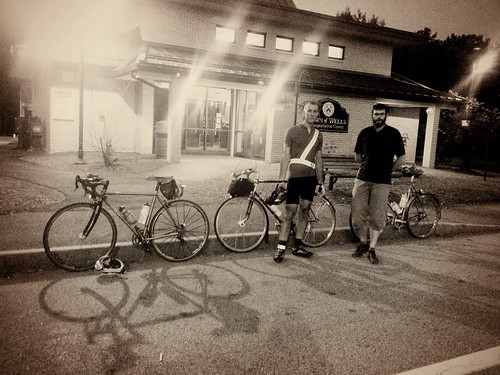
Around 4am we began seeing food delivery trucks, joggers and dog walkers on the roads. Feeling a fresh surge of energy, we made the final miles to Wells, even circling around the train station a couple of times to make sure our ride was a full 100 miles. We checked our computers and saw that our average speed had been 13mph.
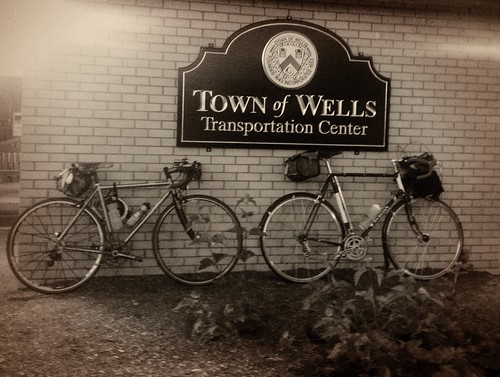
We collapsed outside of the station doors, as it would not be open for at least another hour.

As the sun rose, the station opened. We then waited inside for the 6:30am train. The lady at the station was delighted to learn that we had cycled all night from Boston and were about to take the train back.
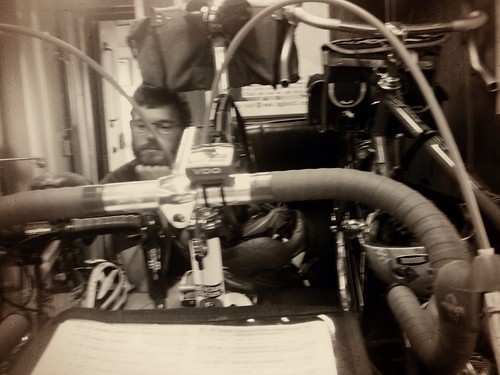
On board the conductor allowed us to take our bikes right into the passenger's car. We sort of jammed them in between the seats. The train car was air conditioned and for the first time on this trip I felt cold. I was glad that this allowed me to make use of the jacket I'd packed. I put it on and promptly passed out in fetal position next to my bike.
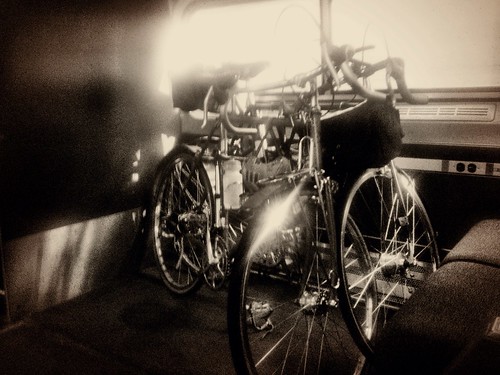
When I opened my eyes we were in Boston, and still half-awake I ushered my bike out of the train. We then took the commuter rail to Somerville (all three of us are practically neighbours) and I - just barely - rode the last mile home from the Porter Square T-station. Then I collapsed and did not wake up until 2pm. And then I took the longest bath ever. And I ate. And I ate some more. Cycling, eh?
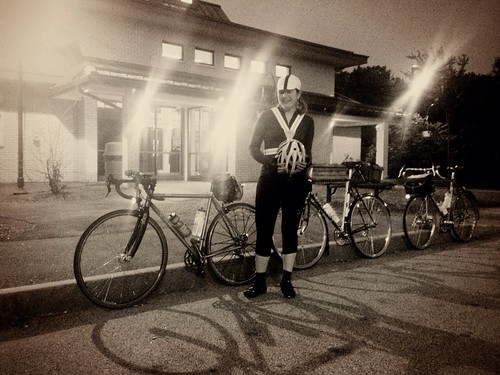
To those of you still reading, I will say this: Randonneurs tend to downplay the difficulty of these rides, but since I am far from a real randonneur I can tell you the truth. Riding long distance is difficult; it is not all flowers and sea breezes and happy pedaling. It is difficult to cycle 100 miles with almost no breaks for the first 68 of those miles. It is difficult to ride all night without sleep. You might get tired. You might hurt in ways you did not even expect. You might feel miserable. So the question is, why do it? As I find myself longing for another ride, I wonder the same thing. For some it's an athlete's high, for others a sense of accomplishment. But I think for me it's more about the magical adventure - adventure that overrides the occasional pain and effort of it. I mean come on - riding my bike from Boston to Maine under a full moon? Beyond my wildest dreams, plain and simple. Thank you to everyone who supported me through this, you know who you are.
More pictures from the ride here. Yet more pictures from Somervillain here. And more still from JP Twins hereand Jon here. Thank you for reading!



 This ship is the George A. Kohler, which was a schooner that was grounded in a 1933 hurricane. This ship sat on the beach for ten years before it was burned for her iron fittings during World War II. The remains of this shipwreck has report to be seen both in the surf and on the sand.
This ship is the George A. Kohler, which was a schooner that was grounded in a 1933 hurricane. This ship sat on the beach for ten years before it was burned for her iron fittings during World War II. The remains of this shipwreck has report to be seen both in the surf and on the sand. And one shot of the gorgeous, bathed in setting sun beach. Notice how empty it is right now!
And one shot of the gorgeous, bathed in setting sun beach. Notice how empty it is right now! Living the life in beach paradise!
Living the life in beach paradise!































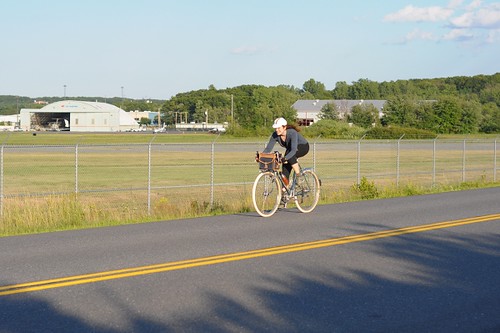 After I wrote about completing my first 100 mile ride on an upright bicycle with an internally geared hub, I've received emails from readers asking to elaborate on the difference between doing long rides on a roadbike versus an upright bike. Previously, I had written that I prefer to ride a bicycle with drop bars for rides longer than 30 miles, and that I prefer to wear cycling clothing on long rides. Yet here I was riding 100 miles on a city bike wearing street clothing. Did I change my mind? Am I saying that roadbikes are unnecessary after all?
After I wrote about completing my first 100 mile ride on an upright bicycle with an internally geared hub, I've received emails from readers asking to elaborate on the difference between doing long rides on a roadbike versus an upright bike. Previously, I had written that I prefer to ride a bicycle with drop bars for rides longer than 30 miles, and that I prefer to wear cycling clothing on long rides. Yet here I was riding 100 miles on a city bike wearing street clothing. Did I change my mind? Am I saying that roadbikes are unnecessary after all?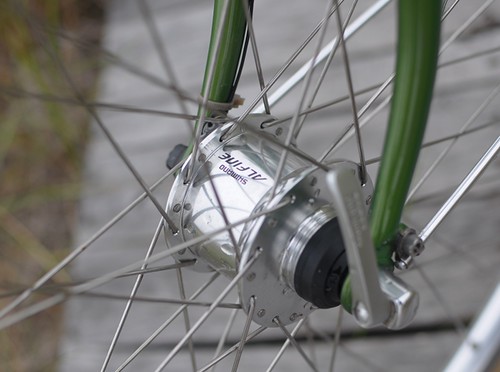 Riding my Rivendell last weekend, I was going downhill when I became aware of a strong vibration in my hands from the handlebars. At first I thought I was imagining it: This felt like "shimmy" and I know this bikedoes not have shimmy; this has never happened before. Was the headset loose? At the bottom of the hill I stopped to check, but everything seemed fine. Then I noticed that my lights were on. I must have forgotten to turn them off from the previous night. And then it hit me: Could this be the dreaded high-speed dynamo hub vibration? Jan Heine mentioned it in a recent Bicycle Quarterly article, and Somervillain reported it after building up his latest bike. In both cases, Shimano hubs were involved. The hub on my bike is a Shimano Alfine.
Riding my Rivendell last weekend, I was going downhill when I became aware of a strong vibration in my hands from the handlebars. At first I thought I was imagining it: This felt like "shimmy" and I know this bikedoes not have shimmy; this has never happened before. Was the headset loose? At the bottom of the hill I stopped to check, but everything seemed fine. Then I noticed that my lights were on. I must have forgotten to turn them off from the previous night. And then it hit me: Could this be the dreaded high-speed dynamo hub vibration? Jan Heine mentioned it in a recent Bicycle Quarterly article, and Somervillain reported it after building up his latest bike. In both cases, Shimano hubs were involved. The hub on my bike is a Shimano Alfine.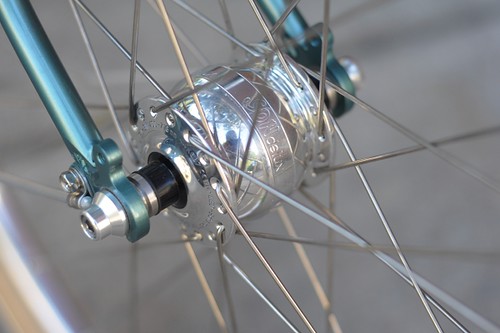 The following day I rode the same route on the Randonneur and intentionally turned the lights on. This bicycle is equipped with a Schmidt SON Delux hub. I did not feel handlebar vibration at high speeds.Reading up on this issue some more, the vibration effect has been reported for many different hubs, including Schmidt - though not the SON Delux model specifically, as far as I can see. Is the SON Delux immune to this?
The following day I rode the same route on the Randonneur and intentionally turned the lights on. This bicycle is equipped with a Schmidt SON Delux hub. I did not feel handlebar vibration at high speeds.Reading up on this issue some more, the vibration effect has been reported for many different hubs, including Schmidt - though not the SON Delux model specifically, as far as I can see. Is the SON Delux immune to this? Carradice bags have been made in England since the 1930s using traditional designs and methods. The bags in the traditional series are hand-sewn, with the name of the person who made each bag written on an inside label. Ours were made by Christine. I find the Carradice Barley ideal for daily use, because it is classic, attractive, durable, compact, and versatile.
Carradice bags have been made in England since the 1930s using traditional designs and methods. The bags in the traditional series are hand-sewn, with the name of the person who made each bag written on an inside label. Ours were made by Christine. I find the Carradice Barley ideal for daily use, because it is classic, attractive, durable, compact, and versatile.


 Inside the bag as pictured on this photo, I have: a rolled-up cable lock, a rain poncho, a saddle-cover, a hat, a cardigan, a pair of flip-flops, sunscreen, baby powder, bandaging tape, a paperback book, an apple, a small bottle of mineral water, 2 small packets of peanut butter, a digital camera, a set of keys, and a mobile phone. The side pockets are especially convenient for storing the mobile phone and camera when I am on my roadbike (which has no front basket) for easy access without getting off the bike. A small waterbottle and candybar will fit in the pockets as well.
Inside the bag as pictured on this photo, I have: a rolled-up cable lock, a rain poncho, a saddle-cover, a hat, a cardigan, a pair of flip-flops, sunscreen, baby powder, bandaging tape, a paperback book, an apple, a small bottle of mineral water, 2 small packets of peanut butter, a digital camera, a set of keys, and a mobile phone. The side pockets are especially convenient for storing the mobile phone and camera when I am on my roadbike (which has no front basket) for easy access without getting off the bike. A small waterbottle and candybar will fit in the pockets as well.
 Here is the attachment to the bag-loops at the back of the saddle.
Here is the attachment to the bag-loops at the back of the saddle. And here is the attachment to the rack.
And here is the attachment to the rack. If your saddle is raised fairly high and/or if you do not have a rear rack, the bag can also be installed at an angle, where the top straps connect to the bag-loops at the back of the saddle, and the bottom strap wraps around the seating post, as shown on the photo above. The bag is designed to accommodate either method and looks great either way.
If your saddle is raised fairly high and/or if you do not have a rear rack, the bag can also be installed at an angle, where the top straps connect to the bag-loops at the back of the saddle, and the bottom strap wraps around the seating post, as shown on the photo above. The bag is designed to accommodate either method and looks great either way.
